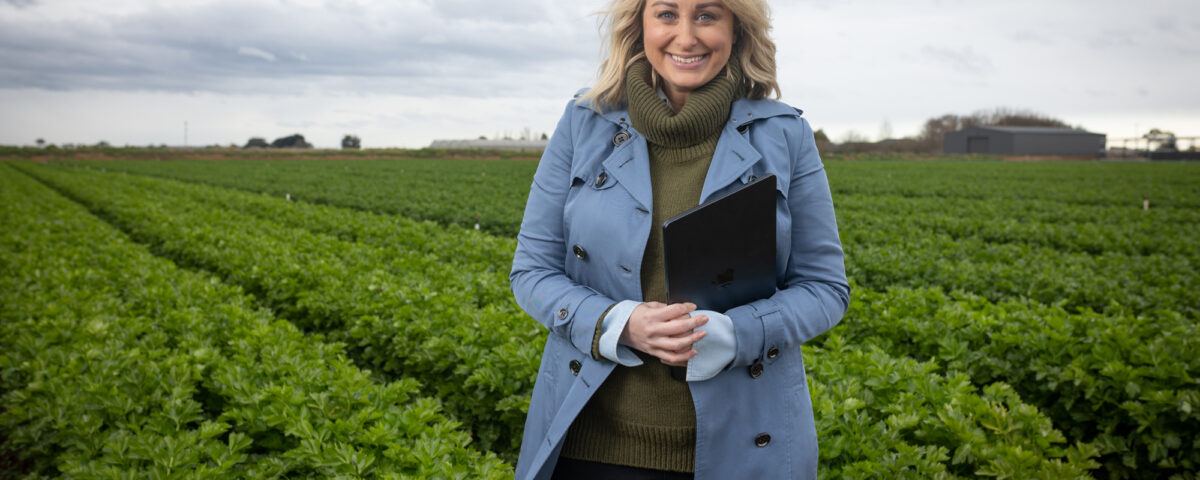Novel technologies and practices for the optimisation of pollination within protected cropping environments
22 August 2024Vegalogue #17 – R&D Edition: Understanding the ‘farmscape’ to manage onion pests with Dr Daniel Drost
2 September 2024Growers could soon have tailored local weather forecasts directly at their fingertips through a ground-breaking program that leverages the cutting-edge capabilities of artificial intelligence and machine learning, combined with traditional weather forecasting techniques.
Farmers talk about the weather – its impact on farm, when to plant, when to irrigate, when to protect crops, and if it will be a good season.
Understanding short term weather forecasts on a day-to-day basis and on a longer term gives farmers another tool to use on farm to maximise productivity.
Presenting at the Australian Vegetable Industry Seminars (AVIS) at Hort Connections 2024, well-respected meteorologist, Jane Bunn, explained how weather patterns affect local conditions and what that means on farm.
Mr Bunn’s company Jane’s Weather, in collaboration with Hort Innovation, has developed a program aimed at significantly enhancing the precision, quality and usability of weather-related information. The $1.3m initiative, delivered through Hort Innovation and led by Jane’s Weather, is tailored to meet the specific needs of individual growers, considering their farming block, unique terrain and operational requirements.
Hort Innovation chief executive Brett Fifield said the project heralds a new era in weather forecasting.
“Horticulture growers face the challenge of making crucial farming decisions based on generic weather forecasts that may not accurately reflect their specific location,” he said.
“Recognising this gap, this innovative project seeks to provide local weather predictions, empowering growers with the ability to make more informed decisions regarding frost management, spraying, irrigation, and pest and disease control, among other critical agricultural activities.
“Machine learning and artificial intelligence are the missing ingredient in solving the problem of what the weather will do next and will give growers the power of being even more accurate, more often.”
Traditional weather models don’t have high levels of local accuracy for most farms due to their distance from official weather stations, according to Ms Bunn.
“By applying machine learning and artificial intelligence to the data from current weather prediction models and local farm weather stations, we can significantly reduce forecasting error,” she said.
“This approach delivers more accuracy, more often, by learning from observations directly from the site, delivering superior results and therefore, superior business outcomes for our clients.”
Jane explained to delegates at Hort Connections that the program gave forecasts that are specific to on-farm, including storm risk, rain and snow, wind gusts, evapotranspiration and spraying conditions.
“If it is showing that evapotranspiration is high for the next few days, then it may influence how and when irrigation is done. The data for growing degree days will indicate how much growth potential there is for your property, which in turn may influence the actions a farmer takes for the next phase of plant growth,” said Jane.
Jane explained that the development of rain is dependent on two factors – moisture and low pressure systems. The influence of sea surface temperatures in the Indian Ocean west of Australia, and the Pacific Ocean to the east, determines how much or how little rain regions of Australia may receive.
“The sea surface temperature is important globally for the weather, as it will determine how much moisture we have,” she said.
“Warmer sea surface temperatures will hold more moisture than cold, and in combination with low pressure systems, we get rain.
“To predict what the rainfall outlook might be, the sea surface temperature in the Pacific and Indian Oceans is monitored. When the temperature is higher than average over northwest Western Australia up to Indonesia, we will have the potential for more rain. If it is cooler, there is less moisture and results in drier conditions for much of Australia.”
Across the Indian Ocean, monsoon season causes sea surface temperature fluctuations. Once into Autumn patterns are more easily followed. It is usually low pressure over the tropics.
Variations over the Pacific Ocean are driven by the Southern Oscillation Index, which determines the probability of El Niño, while the Indian Ocean Dipole is related to La Niña. To be in La Niña, a period of eight weeks in a positive dipole (warmer) is needed. In 2024, Australia had seven weeks.
The collaboration between Jane’s Weather and Hort Innovation will involve identifying and selecting a cohort of farming enterprises to build and test the functionality of the platform. This targeted approach ensures that the developed solutions are practical and meet the real-world needs of growers.
Mulgowie Fresh Agronomy Manager Andrew Johanson said the technology has significant potential.
“Having access to accurate, site-specific weather information will enable growers to make timely decisions that can positively impact our crop yield and quality. This is a major advancement for the horticulture industry, and it is exciting to be a part of it.”

